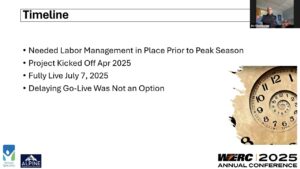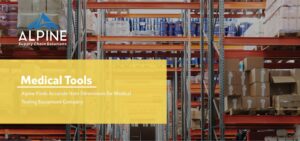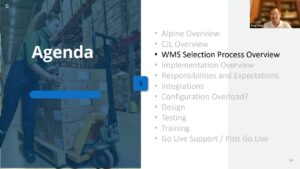Strategic network optimization is a critical process for businesses looking to enhance their supply chain efficiency, reduce costs, and improve service levels. While your operation may seem to be running “smoothly” it’s a good idea to audit your network periodically to ensure you aren’t missing out on any easy wins to improve productivity, service, and the bottom line. During our recent webinar, Optimizing Your Distribution Network for Scalability and Resilience, our experts answered some of the most pressing questions on the topic. You can catch a recording of the webinar here, or read below for the top questions answered during the session.
1. When should a company perform a network analysis?
A company should perform a network analysis when it needs to evaluate or optimize its supply chain, distribution footprint, or logistics operations. There are numerous triggers and reasons for a network analysis, including:
- Strategic growth and expansion
- Cost reduction
- Efficiency improvements
- Mergers, acquisitions, or divestitures
- Shifts in customer demand and service expectations
- Supply chain disruptions
- Risk management
- Technology and automation upgrades
A network analysis shouldn’t be reserved for when there’s a problem to solve. Performed proactively, organizations can ensure necessary changes are not only made before critical issues arise but without negatively impacting day-to-day functioning.
2. Why should a company conduct a strategic network optimization analysis?
A network analysis helps ensure that a company’s distribution strategy aligns with future growth, market expansion, and cost efficiency. While many of the triggers for conducting an analysis also serve as justifications for why it’s necessary, additional factors include:
- Sustainability efforts
- Inventory optimization
- Technology and automation integration
- Labor cost optimization
- Changing regulatory and compliance requirements
- Shifting transportation strategies
3. What are the key costs examined in network optimization?
One of the primary reasons for conducting a network optimization analysis is to uncover opportunities for cost savings. To gain a complete picture, both fixed and variable costs must be carefully evaluated. Variable costs—such as labor, utilities, material handling, equipment maintenance, transportation, and inventory holding—fluctuate based on activity levels. In contrast, fixed costs—including lease or mortgage payments, property taxes, insurance, and security—remain constant regardless of operational volume. A well-optimized network strategically balances these costs to maximize efficiency, reduce waste, and maintain service levels without compromising performance.
4. How do service level expectations impact network design?
Service level expectations directly influence network design by dictating facility locations, inventory placement, and transportation strategies to meet customer demands efficiently. Companies must balance cost and service, determining whether to prioritize speed, efficiency, or a combination of both based on customer expectations. In the end, service level expectations drive a company’s network footprint, inventory strategy, and transportation choices—striking the right balance is crucial to maintaining cost efficiency while meeting customer demands.
5. What are the critical factors in determining warehouse and facility locations?
Optimizing your network may reveal the need to relocate existing warehouses or add new facilities. Key considerations include labor availability, automation potential, inventory strategy, and proximity to customers and suppliers. The number and placement of facilities should be guided by customer service expectations, cost trade-offs, inventory positioning, and geographic reach. Once again, finding the right balance between cost efficiency and service performance is what operations need to ensure seamless operations while minimizing expenses.
6. How does a business decide between using a 3PL or maintaining in-house distribution?
This decision will vary depending on a company’s growth strategy, budget, and operational priorities. Companies weigh factors such as operational control, scalability, cost efficiency, and service flexibility when deciding whether to outsource logistics operations or maintain in-house distribution. Both come with their own set of benefits. A 3PL can offer expertise, infrastructure, and technology that streamline logistics while reducing capital investment. However, in-house distribution provides greater control over operations and customer experience, which may be critical for businesses with unique handling requirements or strict service-level agreements.
7. What role does inventory placement play in strategic network optimization?
Inventory placement is a critical deciding factor in fostering a strategic and reliable network. Different deployment strategies may be designed based on whether items are fast or slow-moving. For example, regional stocking makes the most sense for fast-moving items, whereas centralized stocking should be applied to slow-moving products. Proximity-based inventory should be implemented to account for market demand fluctuations. These decisions help improve service levels while controlling carrying costs.
8. What role do IT systems play in supply chain optimization?
IT systems enable data-driven decision-making, enhancing visibility, and improving operational efficiency across the supply chain. Once the plan for network optimization has been finalized, IT systems such as WMS, TMS, ERP, and order management systems support changes, ensuring the smooth execution of the new strategy. IT systems can help operations design an optimized supply chain network that balances cost, service levels, and agility in a competitive market.
9. How do companies manage data gaps during a network optimization project?
In an ideal world, data is clean, complete, and reliable, but that’s not always the case. For many operations, data gaps can create obstacles to progress. However, these challenges can be effectively addressed with some creativity. Industry benchmarks, project accelerators, and proven methodologies developed through extensive experience can be used to help fill in missing data. Sometimes, exploring alternative approaches and assessing their impact helps to ensure the highest possible level of accuracy.
10. How do regulatory and market changes impact strategic network optimization?
In general, shifts in trade policies, tariffs, and regulations influence sourcing strategies, nearshoring decisions, and supplier diversification. This means businesses must adapt their supply chains to stay compliant and competitive.
For some industries, regulatory needs means network optimization is an ongoing practice. For example, regulatory and market changes impact pharmaceutical network optimization by influencing distribution strategies, compliance requirements, and cost structures. Regulations like the DSCSA (Drug Supply Chain Security Act) mandate traceability, while cold chain requirements affect storage and transportation. Market shifts, such as new drug launches or changes in reimbursement models, can also drive network adjustments. Therefore, pharmaceutical companies must optimize their supply chain networks often to balance compliance, cost-efficiency, and market demand.
11. What are the first steps to engaging in a network optimization project?
Like any critical operational initiative, a network optimization project begins with an initial inquiry to understand business needs, define the project scope, and outline data requirements. Regular discussions with leadership are essential to establish clear objectives and ensure alignment from the start. This foundational step enables the team to implement a structured methodology, which is crucial for maintaining focus and accuracy before diving into in-depth analysis.
12. How does network optimization affect transportation costs and strategies?
Network optimization directly impacts transportation costs and strategies by identifying the most efficient routes, modes, and distribution points to minimize expenses while maintaining service levels. It evaluates factors such as carrier selection, load consolidation, backhauling opportunities, and distribution center placement to reduce mileage, fuel consumption, and transit times. With data-driven insights, businesses can determine the best balance between cost and speed, whether through parcel, truckload, or a multi-modal approach. Network optimization also helps mitigate risks related to capacity constraints, seasonal fluctuations, and evolving customer demands.
13. What challenges do companies face when executing a strategic network optimization strategy?
In addition to aligning organizational capabilities, system integrations, and managing change, companies executing a network optimization strategy face challenges such as:
- Data accuracy and visibility: It can be difficult to ensure decisions are based on real-time, high-quality information across the supply chain.
- Regulatory compliance: Can complicate optimization efforts, particularly in industries with strict safety, environmental, or trade regulations.
- Balancing cost and service levels: Optimizing for efficiency must not come at the expense of customer expectations, so striking the right balance is vital.
- External disruptions: Geopolitical shifts, natural disasters, or supplier instability, can all further impact long-term network viability, requiring businesses to build flexibility and contingency planning into their strategy.
14. What are the common benefits of a network optimization project?
A well-optimized network delivers significant operational and financial benefits by aligning supply chain resources with business objectives. The key advantages include:
- Cost Reduction: Optimizing facility locations, transportation routes, and inventory levels leads to lower operating expenses, reduced transportation costs, and improved asset utilization.
- Improved Service Levels: Faster, more efficient order fulfillment enhances customer satisfaction by ensuring timely and accurate deliveries.
- Optimized Facility Use: Streamlining distribution center placement and warehouse operations maximizes efficiency and minimizes excess storage costs.
- Enhanced Delivery Speed:Strategically placed distribution points and optimized routing reduce lead times and improve last-mile delivery performance.
- Increased Flexibility for Future Growth: A well-structured network allows businesses to scale efficiently, adapt to market changes, and integrate new technologies or locations.
At Alpine, we’ve found that most projects result in a 10-15% total supply chain cost reduction. For example, we worked with a home supply wholesaler that consolidated branches and deliveries, leading to a 12-18% reduction in facility operating costs and a 3-5% decrease in fleet costs. These measurable gains highlight the value of a data-driven network optimization approach.
These are just some of the key questions we answered during our webinar. If you missed the session or want to revisit any details, the full recording is available on our website. If you’re ready to have us help you make the most out of your supply chain investment, reach out to our team!













